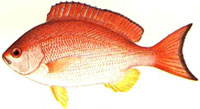
Lutjanidae
The snappers are a large and diverse group of robustbodied, carnivorous fishes. Most species possess relatively large mouths with stout canine teeth and bodies covered with relatively large, coarse scales. They are frequently brightly coloured. They are demersal (spending most time swimming close to the sea bed) in some cases down to 450m and are found in the tropical and sub topical waters of the Atlantic, Indian and Pacific Oceans.
There are over one hundred individual species globally, but within the Pacific Coast Sub-tropical eco region there are only a limited number of species that you are likely to see at diving depth, and these will tend to be in the warmer waters of the region.
Read More








Social Profiles